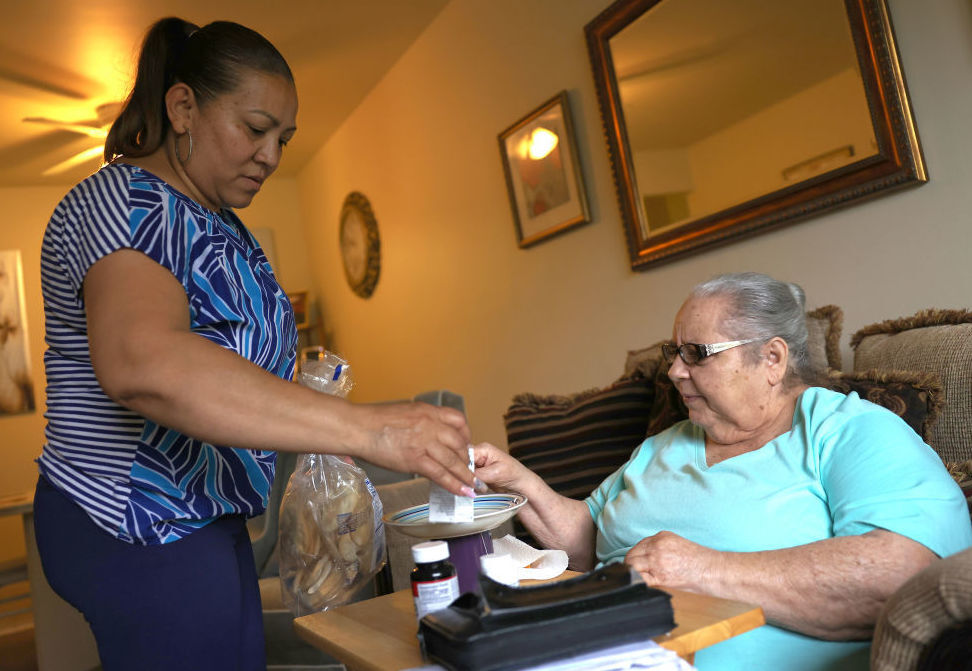
[ad_1]

Expanded funds for in-home care can help seniors and disabled Americans stay in their homes. Here, Lidia Vilorio, a home health aide, gives her patient Martina Negron her medicine and crackers for her tea in May in Haverstraw, N.Y.
Michael M. Santiago/Getty Images
hide caption
toggle caption
Michael M. Santiago/Getty Images

Expanded funds for in-home care can help seniors and disabled Americans stay in their homes. Here, Lidia Vilorio, a home health aide, gives her patient Martina Negron her medicine and crackers for her tea in May in Haverstraw, N.Y.
Michael M. Santiago/Getty Images
For older people and people with disabilities, solving everyday practical problems can be the difference between being able to live at home or being forced to move to an institution. Sometimes people need help getting dressed or making meals. Sometimes they need help managing medications or shopping for groceries.
Originally, these things weren’t paid for by Medicaid, the federal health care program that many low-income and disabled Americans rely on. In recent years, the program has worked to expand coverage of home-based care but it’s still optional for states. Some states have adopted it widely, while in others, more care still happens in nursing homes and other institutions.
In April, the Biden administration rolled out funding from the American Rescue Plan to help states boost these services. And Thursday, the federal Department of Health and Human Services unveiled every state’s plan for how they’ll use the funds. An estimated $12.7 billion dollars in federal matching funds are available to “encourage states to expand home and community-based services and strengthen their programs,” according to an agency press release.
“More and more people are saying, if I need care, I’d like it to be done at home or here in my community versus an institution or a hospital or a nursing home,” says Health Secretary Xavier Becerra. “In the 21st century, we’re moving closer to a care model that’s based on giving people services in their home.”
Becerra adds that his own father spent his last few months in hospice at home. “When he passed, he was in my home, he was surrounded by family,” he says.
Medicaid recently surpassed 80 million beneficiaries — the most ever since the program was created in the 1960s. It is the primary provider of long-term care services for older people, since these are not covered by Medicare or private insurance.
The move towards home- and community-based care has been gradual since Medicaid started, says MaryBeth Musumeci, an associate director at the Kaiser Family Foundation’s program on Medicaid and the uninsured. “This is really the first new funding that we’re seeing for home and community based services really since the Affordable Care Act in 2010,” she says.
“Back in 1965, the world was very different, societal expectations were different,” she explains. “For example, if you had a child born with a significant disability, it was much more likely that you might institutionalize that child from a very young age. Medical science and technology had also not advanced to the point where it is now.”
These days, it’s both possible and preferable for everyday help to be provided to people at home, she says.
There are a lot of reasons why the shift towards home-based care is a good thing, says Jack Rollins, director of federal policy at the National Association of Medicaid Directors.
For someone who needs these services, “you can get care from your family [or] from people that you trust in the community who can come into your home,” he says. “It generally costs less than providing these services in the nursing home. Folks that receive [these services] are generally happier with them — they prefer it.”
He adds that regardless of where states are now in terms of offering these services, this new funding will help move them further along. For instance, he says, “one of the things that generally Medicaid can’t directly pay for is internet connectivity — with these dollars, it looks like we can.” That means people could get consistent broadband internet access, he explains, which could allow them to use telehealth services.
There’s a time limit to this funding boost, though. The money provided by the American Rescue Plan to shore up these services “is a meaningful amount, but the challenging part is it’s limited to 12 months,” explains Musumeci.
Many Medicaid advocates are hoping that more permanent support for these services will come through in the budget bill getting hashed out in Congress.
“We do remain hopeful that that investment gets through in some form or fashion,” says Rollins. “We think it’s important.”
The health secretary says he thinks so, too. “We’re hoping that Congress will continue to provide additional resources so we can make those increased services in home and community based settings permanent,” Becerra says. Through the COVID-19 pandemic, he adds, “Medicaid proved its value.”
[ad_2]
Source link